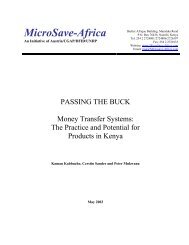You also want an ePaper? Increase the reach of your titles
YUMPU automatically turns print PDFs into web optimized ePapers that Google loves.
Photo by Mary Jane Stickley, <strong>DAI</strong><br />
<strong>DAI</strong>’s shift to a<br />
greater emphasis on<br />
commercial, rather<br />
than government,<br />
projects started from<br />
the ground up in<br />
Indonesia.<br />
24<br />
<strong>DAI</strong>’s leaders went into the 1980s with<br />
high expectations based on the growth spurt<br />
<strong>of</strong> their recent past. But these advocates <strong>of</strong> the<br />
“process approach” were soon disappointed,<br />
as the vision that reverberated at the Homestead<br />
gave way to a realization that the market<br />
was changing, and some difficult adjustments<br />
would have to be made. The long-term USAID<br />
contracts that had ramped up <strong>DAI</strong>’s revenue<br />
were running their course, and prospects for<br />
replacing them were easier to imagine than<br />
capture. As it turned out, the slowdown <strong>of</strong> the<br />
early 1980s was a partial blessing, allowing the<br />
company to strengthen its internal systems and<br />
focus on improving its implementation capacity.<br />
At mid-decade, <strong>DAI</strong> began growing again,<br />
although for Don Mickelwait, at least, the lure <strong>of</strong><br />
diversification had still not produced the desired<br />
results. As the 1990s began, <strong>DAI</strong> narrowly<br />
escaped a merger that initially seemed very<br />
advantageous, but would have been a disaster.<br />
Management regrouped, and recognized that<br />
the company was now better positioned to<br />
chart its own course, and new market opportunities<br />
emerged that opened the door to a long<br />
period <strong>of</strong> steady, pr<strong>of</strong>itable growth.<br />
The View from the Plateau<br />
The enthusiasms <strong>of</strong> summer 1980 led naturally<br />
into new initiatives. One <strong>of</strong> the biggest was the<br />
opening <strong>of</strong> <strong>DAI</strong>’s first regional <strong>of</strong>fice in Jakarta,<br />
Indonesia, in September <strong>of</strong> that year. The <strong>of</strong>fice<br />
was the brainchild <strong>of</strong> Jerry Silverman, who had<br />
led the Provincial Area Development Program<br />
(PDP) and persuaded Mickelwait that this was a<br />
beachhead for multiclient expansion in Indonesia’s<br />
sizable market for development consulting<br />
services. Both believed the <strong>of</strong>fice would provide<br />
credibility with the World Bank, the Asian Development<br />
Bank, and the Indonesian government,<br />
and open the door to work with private sector<br />
clients. Silverman’s continuing part-time responsibilities<br />
on PDP diluted this effort, however,<br />
and <strong>DAI</strong> never figured out how to market its<br />
services outside <strong>of</strong> the familiar USAID domain.<br />
By 1982, the cost <strong>of</strong> the Jakarta <strong>of</strong>fice (well over<br />
$100,000 annually) was a drain on <strong>DAI</strong>, and<br />
Mickelwait decided to close it. But the appeal <strong>of</strong><br />
Indonesia remained as strong as ever.<br />
At the time, 99 percent <strong>of</strong> <strong>DAI</strong>’s revenues came<br />
from public sector clients, and almost all <strong>of</strong> that<br />
from USAID. The election <strong>of</strong> Ronald Reagan in<br />
1980 seemed likely to reduce U.S. foreign aid



